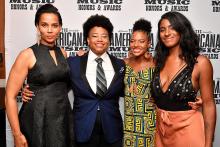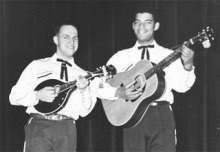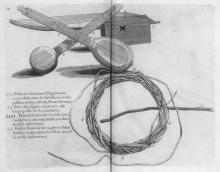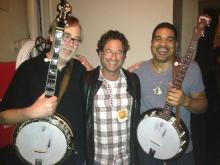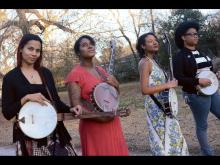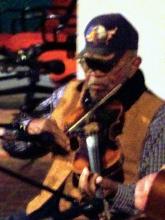OHR Offstage: Featuring Dom Flemons, Don Edwards & Jerron Paxton
Ozark Highlands Radio is a weekly radio program that features live music and interviews recorded at Ozark Folk Center State Park’s beautiful 1,000-seat auditorium in Mountain View, Arkansas. In addition to the music, our “Feature Host” segments take listeners through the Ozark hills with historians, authors, and personalities who explore the people, stories, and history of the Ozark region.
This week, two Grammy Award winning old time musicians and an up and coming folk/blues sensation perform live at the Ozark Folk Center State Park Craft Village. Featured on this special episode are Dom Flemons, Don Edwards, and Jerron Paxton.
One of the unique experiences for visitors to the Ozark Folk Center is the intimate matinee performances by our guest musicians. The shows are a unique way for musicians and guests share a time and space much different than a traditional indoor performance venue. There are often Q &A sessions, jokes, stories and of course, the occasional request from an audience member that make these sets so popular.
These performances take place in the backdrop of the Ozark Folk Center State Park Craft Village, a large outdoor area, home to over 20 artisans who demonstrate traditional and contemporary craftsmanship on site. Nestled in the center of the Craft Village is an old wooden covered stage. The area seats about 50 people but is always overflowing with people for the matinee sets by our guest artists.
Dom Flemons is a Grammy Award winning musician & singer-songwriter. Carrying on the songster tradition, Flemons strives to mix traditional music forms with a contemporary approach, to create new sounds that will appeal to wider audiences. Flemons co-found the Carolina Chocolate Drops, an African-American string band that won a Grammy for its 2010 album Genuine Negro Jig. Today, he tours throughout the United States and internationally as “The American Songster.
One of America’s best loved and most enduring cowboy singers, Don Edwards is indeed an American treasure. His love and passion for traditional cowboy songs is second to none and has earned him a fan base worldwide. He knows the songs, the stories, and even some of the old trails that made the old West famous. Accompanied by his trusty guitar, Don takes us on a trip back in time when cowboy singers and songs echoed through the trails, taverns, and cattle drive camps of yesterday.
Jerron "Blind Boy" Paxton is an American musician from Los Angeles. A vocalist and multi-instrumentalist, Paxton's style draws from blues and jazz music before World War II and was influenced by Fats Waller and "Blind" Lemon Jefferson. According to Will Friedwald in the Wall Street Journal, Paxton is "virtually the only music-maker of his generation—playing guitar, banjo, piano and violin, among other implements—to fully assimilate the blues idiom of the 1920s and '30s, the blues of Bessie Smith and Lonnie Johnson."
In this week’s “From the Vault” segment, musician, educator, and country music legacy Mark Jones offers an archival recording of Ozark original Adrian Parks performing the classic song “Under the Double Eagle,” from the Ozark Folk Center State Park archives.
From his series entitled “Fine Fiddlers of the Ozarks,” old time and Ozark fiddle aesthete Roy Pilgrim profiles the legendary Ozark fiddler Uncle Dick Hutchinson. This installment features archival recordings of the classic fiddle tunes “Christmas Eve, Judge Parker Take Your Shackles Off, Hell on the Nine Mile, and Sharecropper’s Blues.”
Musical Works
Title - Artist - Year
- Have I Stayed Away Too Long - Dom Flemons - 2016
- Hot Chicken - Dom Flemons - 2016
- Polly Put the Kettle On - Dom Flemons - 2016
- Going Down the Road Feeling Bad - Dom Flemons - 2016
- Lonesome Old River Blues - Dom Flemons - 2016
- Under the Double Eagle - Adrian Parks - 1973
- Blues Yodel #7 - Don Edwards - 2016
- The Cowboy’s Last Ride - Don Edwards - 2016
- When the Work’s All Done This Fall - Don Edwards - 2016
- My Blue Heaven - Don Edwards - 2016
- Hesitation Blues - Jerron Paxton - 2016
- Mississippi Bottom Blues - Jerron Paxton - 2016
